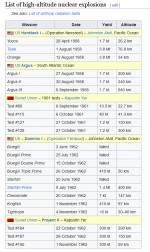I have two questions on this topic that I've NEVER heard answered.
I keep reading that a nuclear weapon exploded at "high altitude" would be necessary to generate an EMP.
HOW "high"?
In the book, "One Second After", apparently the weapon was detonated IN SPACE---so far out into the far reaches of Earth's atmosphere that no one saw or heard the nuke go off.
They just noticed the power went off-and wondered what happened.
So--in REALITY---How "high" is "high"--------iow--is it possible for a nuclear device to be detonated over the US, but NOT "close" to the US in terms of altitude--so that it truly could be said to be set off "in space" rather than "over the US"--and "if" a nuke was set off "in space," that high in the atmosphere: Question 1: COULD It even do what they claim (given that solar flares do the same, I assume the answer to that is "yes") Question 2: "IF" set off that "high," ----would the nuke truly be so far out it would not be observed either visually or audibly by those on the ground?

The above chart indicates date,size, and distance.
A couple of points, this type of testing ended in late 1962. 61 years ago.
Another is space weather conditions have experienced major changes since then with the degradation of the earths magnetic fields, and the recent detection of solar gamma radiation. See
MSU scientists help make a surprising discovery about the sun . There's a slide in the OP presentation positing gamma radiation is the driver.
Keeping these changes in mind, perhaps the results of those previous tests may differ today.
Setting off a nuke in space is akin to mutually assured destruction to to the heavily saturated satellite population today, versus the minuscule numbers in 1962.
Since the presentation is based on amateur radio communications (HAM) and possible protective measures during an attack, it does not address a solar induced event. I did learn some fascinating facts from the video and thought some of our members might appreciate the presentation.
===
.





 In Texas or Florida.
In Texas or Florida.

